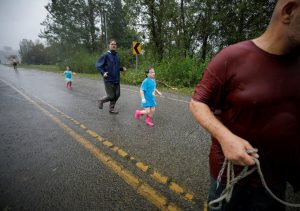
By Ernest Scheyder and Patrick Rucker
WILMINGTON/FAYETTEVILLE, N.C. (Reuters) – Deeper flooding loomed in the hours and days ahead from rivers in the Carolinas swollen by Tropical Depression Florence, which has killed 23 people, even if rain-weary residents got a brief glimpse of sunshine on Monday.
The slow-moving storm, a hurricane when it hit the North Carolina coast, has dumped up to 36 inches (91 cm) of rain on the state since Thursday, displacing thousands. The flooding could persist for several weeks in some areas.
The coastal city of Wilmington remained cut off by floodwaters from the Cape Fear River on Monday. Further inland, the same river, running through Fayetteville, a city of 200,000, was expected to reach major flood levels later on Monday, and would not crest until Tuesday.
Florence was headed through Virginia and toward New England and flash flood watches extended from Maryland through New York and southern New England.
In the Carolinas, the National Weather Service continued to warn people the floods were worsening.
“The worst is yet to come,” as river levels rise to historic levels, said Zach Taylor, an NWS meteorologist. “The soil is soaked and can’t absorb any more rain so that water has to go somewhere, unfortunately.”
Major rivers are expected to remain flooded for the next two to three weeks, said Steve Goldstein, National Oceanic and Atmospheric Administration liaison to the U.S. Federal Emergency Management Agency (FEMA).
The death toll from Florence, which came ashore in North Carolina on Friday, rose to 23 on Monday.
The dead included a 1-year-old boy who was swept away from his mother as they tried to escape their car amid floodwaters. The woman had driven around barricades to get on a closed road, the sheriff’s office in Union County, near North Carolina’s border with South Carolina, said on Facebook.
North Carolina officials reported 1,200 road closures, including a stretch of Interstate 95, a major transportation artery running the length of the U.S. East Coast.
About 509,000 homes and businesses were without electricity on Monday in North and South Carolina and surrounding states.
POWER OUTAGES, BLOCKED ROADS
The sun appeared in some areas for the first time in days, allowing some people who had been forced to leave their homes to return home to assess damage.
Eric Tryggeseth, 59, found his home in Leland, North Carolina, without power and with a tree lying in his front yard. He had been evacuated a day before by troops in a truck.
“The floodwaters were rising so I figured I better get out of there,” he said. “I can’t thank the first responders enough.”
There were currently 2,000 federal workers working on storm response, supporting state efforts, said Tom Fargione, FEMA Federal Coordinating Officer, during a press conference.
Sean Adams, 29, a contractor from Leland, said his home suffered only minor damage but he had no idea when power might be restored.
With so many roads in and out of the region flooded, he could not access supplies to help start rebuilding.
“We really can’t get much done right now. It’s getting frustrating,” he said.
The storm killed 17 people in North Carolina, including a mother and child hit by a falling tree, state officials said. Six people died in South Carolina, including four in car accidents and two from carbon monoxide from a portable generator.
(Reporting by Patrick Rucker and Ernest Scheyder; Additional reporting by Bernie Woodall in Miami; Jessica Resnick-Ault and Barbara Goldberg in New York; Anna Mehler Paperny in North Carolina; and Rich McKay in Atlanta; Writing by Bill Trott; Editing by Nick Zieminski and Frances Kerry)


